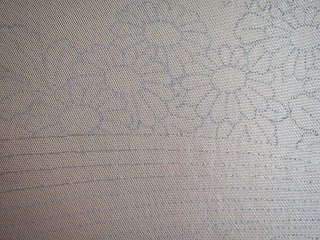© JEC/Carol-Anne Conway
At each phase the student has some choice of designs. Over the years some designs have been phased out (no pun intended) and new ones introduced. Taking into account only those designs currently offered on the JEC website there are, by my calculation, 4608 different combinations of Phase I through Phase IX.
For me the choices at each phase were fairly simple until it came to Phase IX. Of the four designs available (only three are shown on the website) I could easily have chosen any one of three. In the end it was an unusual stroke of luck that made the decision for me.
In 2011 the JEC held a silent auction of items that had been donated to them, including some designs that students had purchased but, for some reason, had never stitched. Among the items on offer was Konbuin-no-Fukusa – Sake Box with Ladle (see picture 13) on vintage silver nishijin fabric. My original tutor and sensei, Margaret Lewis, has waxed lyrical about the superior quality of the vintage metallic fabrics and lamented that they are no longer available. The description of the lot stated that the fabric was 15 inches long. If that was correct, this would not be long enough to accommodate the whole design but the image (difficult to see clearly because the design is printed onto the fabric in pale blue dots) appeared to have the whole design. I decided to bid on the item regardless. If I won, and it turned out to be the whole design I would stitch it as my Phase IX piece, otherwise I would be content that I had a design on antique metallic fabric in my stash and I would choose another design for Phase IX. I did win and the fabric turned out to be 22 inches long containing the whole Sake Box with Ladle design.
© JEC/Carol-Anne Conway
Ahead of the class in March this year, I visited my tutor for a lesson on double lacing and to choose my silks. I stayed with the traditional red, white and gold pallet for the chrysanthemums but we choose slightly different shades that work better with the silver background.
Back home I framed up and started the lengthy process of outlining the sake box, the long handled ladle and the noshi papers with Japanese running stitch. I had hoped to stitch the foundations before class but did not get that far.
© JEC/Carol-Anne Conway
One thing that all of the Phase IX designs have in common is that they are big designs, far bigger than most of the earlier phase pieces, and they are all reputed to be more challenging that the earlier phase pieces, I suppose that is to be expected. Sake Boxes contains many chrysanthemums. All of the petals, hundreds of them, are stitched in diagonal layer, the stitch I find most difficult to execute well especially on small scale. I hope to have mastered it by the time I complete Phase IX.
Happy Stitching




3 comments:
It seems to me you will have so much practise in that technique, you should have it down pat by the time this one is finished!
That was a stoke of luck getting the auction lot. Have you counted the number of chrysanthemums?
How wonderful getting the vintage silver silk. I bet it's just beautiful.
I've really enjoyed reading the subsequent posts, especially those on stitching the flowers.
Post a Comment